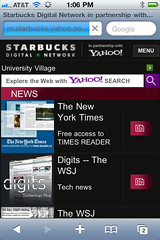I'm a bit dubious about the vast amount of overhype pouring out about white-space spectrum after the FCC's new rules were set (PDF file): I don't see how what's postulated is possible. The TV channels in question are 6 MHz wide. Shannon's Theorem always wins. Channel capacity is a function of bandwidth mitigated by the level and ratio of signal to noise.
Wi-Fi can use 20 to 40 MHz channels in 2.4 and 5 GHz, and likely 80 MHz or more in future 5 GHz iterations. Without multiple radio receivers, encoding improvements in 802.11n over 802.11g bumped the raw rate from 54 Mbps to about 65 Mbps. Take two radios and 40 MHz, and your raw rate approaches 300 Mbps. Three and four radios and 450 Mbps to 600 Mbps.
White-space spectrum can only be used in 6 MHz blocks. Even with an extremely efficient encoding, I don't see how one can get more than 15 to 20 Mbps out of a channel. I've seen several statements that white-space networks will hit 400 to 800 Mbps.
The high power that's allowed--4 watts EIRP, the effective power after antennas--is pretty remarkable. Wi-Fi is limited to 1w EIRP, and in the nature of radio waves a 4fold increase in EIRP means more than 4fold improvement in distant reception. Correction: Wi-Fi is limited to 1W of transmitter power, but 4W of EIRP. The greater range of white-space devices will come from much, much lower frequencies, which carry further and penetrate better.
However, my understanding is that by the same token, MIMO is ineffective because MIMO doesn't work over long distances. It requires reflection over short spaces to provide the multiple spatial paths that boost speed. So by going long, you lose MIMO, and encode with a single radio.
Also by going high power, you lose the advantage of cellular infrastructure, whether for Wi-Fi or 2G/3G/4G mobile networking. The greater area you cover, the more your shared medium is split among users, even in a contention-free scheduled environment, which will likely not be what happens. As an unlicensed band technology, you could be contending with interferers of all kinds the higher power you use and greater area you cover.
Now perhaps the 400 to 800 Mbps figure is if you took all the white-space in a given market and bonded it together with a transceiver that could handle multiple separate bands at once. Or it's 400 to 800 Mbps of aggregated additional capacity, not for one device. (I can't run down the source of the number, only uses of it without reference.) By that token, Wi-Fi in 2.4 GHz and 5 GHz would add up to several Gbps.
I also haven't run through channel maps in given markets under consideration. How many channels are free in urban areas where a dense deployment would make sense? One colleague wrote to say he believes only a couple may be available for unfettered use.
I'm not even getting into the issue of competing licensed uses, the set aside by the rules of two channels in each market for wireless mics, and the ability for special-event permits and special-use mic permits (limited in area) that would trump pure unlicensed networking purposes, too.
Further, there's a canard circulating about how Microsoft has "covered its campus" with two white-space transmitters. That's true--that's not the canard. No, the problem is that Microsoft can serve the space but not the user base with two transmitters, even if the transmitters could handle the mythical 400 to 800 Mbps of raw throughput. (I should note that Microsoft has nothing to do with spreading this notion; Microsoft Research has a been a very reasonable driver, promoter, and engineer on this spectrum. Visit the Networking over White Spaces site for more information.)
Microsoft installed thousands of Aruba Wi-Fi access points across its campus a few years ago not just to provide coverage but also to provide bandwidth. WiMax has been hyped in the same way. You can have distance or speed but not both: the more area you cover, the more users you cover, the more you have contention for air space or time slots, and the less bandwidth available to each user.
White-space spectrum will spawn a lot of interesting devices, and I could see companies and buildings migrating to it for particular purposes. But replace a cellular network or Wi-Fi? I'm not seeing it yet. I welcome more insight in the comments.
Sonic Youth, The Kills to appear on Elijah Wood charity albumWhite Space Spectrum Rules Should Please Dolly Parton






